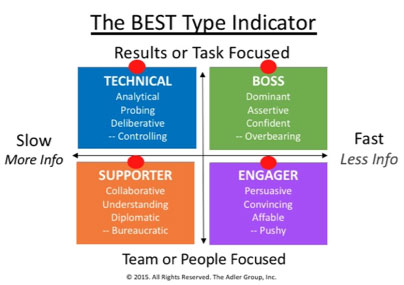03 May Eliminating These 3 Common Tools Will Disrupt (and Improve) Your Hiring Process
Eliminating These 3 Common Tools Will Disrupt (and Improve) Your Hiring Process

Hiring better people starts by disrupting the hiring process as we know it, and disrupting the hiring process starts by eliminating certain tools.
It’s no secret that I consider psychological pseudo-tests like Predictive Index and DISC for assessing candidates as counterproductive, the use of behavioral interviewing as misguided and that the marketing of skills- and experience-laden job descriptions as ineffective for attracting the best and most diverse talent.
Below, I’ll share exactly why I think you should remove these three tools from your hiring process in order to improve it and hire the best talent.
1. Personality and work style assessments
You’ll quickly discover the flaws in personality testing for screening and selection purposes by seeing how simple it is to figure out your personality style.
Start by reviewing the BEST Type Indicator graphic and put yourself on the right side if you prefer to make quick decisions and on the left if you’re more cautious.

Next, put youself on top if you tend to focus more on results than people and on the bottom if the reverse is true. Based on this left vs right and up vs down parlor trick you’re either a Boss, Engager, Supporter or Technical.
Now of course I could add a lot of questions, and some statistical validation and charge you some big bucks to refine your BEST or comparable DISC or PI style, but it doesn’t take much insight to see how anything that can be figured out over a beer must be used with extreme caution, or not at all, when screening people out or in of the selection process. For one thing, these style preferences have nothing to do with competency. In fact, the best people are flexible enough to adapt their natural interpersonal style depending on the situation, and the least best, can’t or won’t.
For example, consider the best managers, leaders and decision-makers. Regardless of their preferred style, they move towards the center or coaching position to better understand the perspective of people with different styles. The least flexible people tend to move away from the center exacerbating their core style, especially under pressure. In these cases, the Boss becomes belligerent, the Engager becomes pushy, the Supporter becomes bureaucratic and the Technical becomes controlling.
2. Behavioral interviews
For different reasons, I find traditional behavioral interviewing also counterproductive and of limited value. The biggest problem for me is the common knowledge that it takes multiple behaviors working in tandem to achieve any level of project or team success. Assessing any competency or behavior independently totally ignores this critical point.
That’s why I spend a lot of time digging into a candidate’s major accomplishments to find out what mix of skills, competencies and behaviors were used to achieve the results required. As important is how this mix has changed over time. This mix change turns out to be a great predictor of potential. From a practical standpoint, it’s far easier to make an accurate assessment by comparing the candidate’s accomplishments to the actual performance requirements of the job.
Of course, to make this type of assessment you need to first define the job as a series of performance objectives rather than a list of skills and experiences. Which gets me to my final argument and why skills and experience-based job descriptions should be discarded…
3. Skills and experience-based job descriptions
It’s what a person does with his or her skills that is what should be measured during the interview, not their absolute level or quantity. If the person has achieved comparable success doing comparable work, she/he will have the perfect mix of skills, experiences, competencies and behaviors to succeed in the new role. And most often, if not always, this mix will be different than what’s listed in the job description.
So if you filter on the skills and competencies listed on the traditional job description you will never see these people. And if you screen them on some type indicator like BEST, PI or DISC, you will never see nor interview nor hire these people. And if you conduct a traditional behavioral interview you will never know if the person is competent and motivated to do the work you need done. Most important of all, by eliminating them all you’ll be able to disrupt the hiring process at your company and start seeing and hiring stronger and more diverse people.
*Photo by Alice Achterhof on Unsplash
To receive blog posts like this one straight in your inbox, subscribe to the blog newsletter.



Sorry, the comment form is closed at this time.